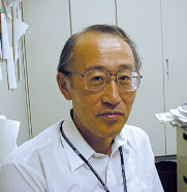
 |

|
KOMIYAMA Bokuji Adaptive Communications Research Laboratories |
|
The device research group is rather the minority at ATR, even in view of total accumulated number of researchers since the foundation of ATR. The group is currently working on optical devices for optical wireless links, which will be used complementarily with radio wireless links in wireless ad hoc networks. The major research results for the last 7 years, which were presented in the press, or published in prestigious journals, are "Polarization mode controlled VCSELs (Vertical Cavity Surface Emitting Lasers)" in December 1996, "Quantum cascade lasers", June 2000, "Micro-origami", June 2001, "Microcavity lasers", February 2003, and "LED (Light Emitting Diode) arrays", in March 2003. The features of Micro-origami were introduced in the journal Nature and the microcavity laser was shown on the cover of the journal Physical Review Letters. We have been conducting research on GaAs (gallium arsenide) based optoelectronic devices, especially focusing on high index GaAs substrates. Although the group is only small, we have been achieving worldwide recognition for the high level and originality of our research results. On the other hand, most device research never progresses quickly, but takes long time for pre-device steps like optimization of thin film deposition condition, studies of interface morphology of junctions, and so on. Therefore, the progress of device research often keeps different pace with other research subjects and there is some difficulty to match the phase of the device research with the targets of short-term projects. Another specific point of device research is that it requires huge amounts of research budget for expensive facilities like epitaxial growth equipments, characterization equipments, and so on. We are now at a turning point in regard to how to position our device research from the viewpoint of technology transfer under the current TAO program. Generally speaking, we should aim for research which is more long-termed than the concrete research common among industries and, at the same time, more short-termed and practical than that performed in universities and national laboratories. One more answer to the question, why the research has to be performed at ATR, is to develop devices which are based on original techniques. It is, however, not easy to propose actual research subjects which meet these two conditions and also contribute to technology transfer. The research on microcavity lasers is a good example of effective use of external resources. We have been concentrating on fundamental design and analysis, preparation of multilayer semiconductor material, and device testing. Universities have been assisting us with design of devices and device measurements. The fabrication of devices has been done by another company. When the human resources of the group are taken into consideration, we should take advantage of these kinds of collaboration more often. We are planning, additionally, to ask ATR partner industries to join more collaborations with us, which will result in more fruitful technology transfer. Details of the ATR industrial partner program are given in our Web site. This special issue discusses four topics, focusing on application of our devices. Some industries are putting stress again on long-term basic research, after reassessing their recent excess bias for short-term research and development. I hope this issue will become a powerful trigger for partner industries to discuss collaboration with us in device research.
|
||